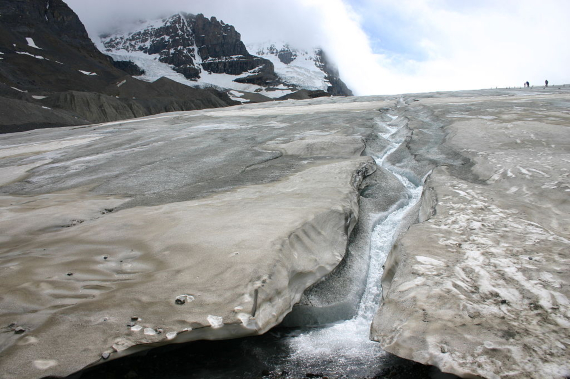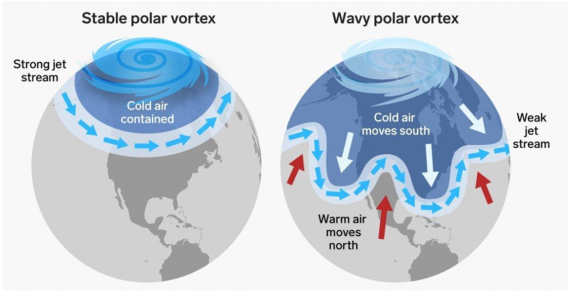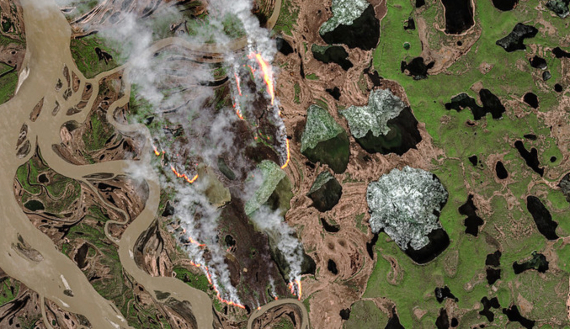The gambling mecca of Las Vegas used to promote itself and its adult-oriented entertainment with the slogan: “What happens in Vegas, stays in Vegas.” While every year tens of millions of people enjoy its neon lights, glitzy charm and “secrets”, far fewer will even set foot in the Arctic. There, the appropriate slogan is just the opposite: “What happens in the Arctic, doesn’t stay in the Arctic”, because the rapid transformation that this region of the planet is undergoing due to global warming affects us all.
But unlike Las Vegas, which keeps its cards close to its chest, the effects of a warming Arctic are spilling out across the globe, disrupting weather and rainfall patterns, raising sea levels and weakening ocean currents. It is also fuelling natural disasters like wildfires, droughts, floods and extreme snowstorms, such as those experienced in the winter of 2021, even in temperate regions such as Spain and Texas.
Arctic amplification
The Arctic is warming at about twice the global average because of a phenomenon known as “Arctic amplification”. There are a variety of mechanisms at play, one of which is albedo, a measure of the reflectivity of a material. Snow and ice have a high albedo, absorbing little or no sunlight, which is the reason we wear sunglasses when we hit the slopes on a sunny day, and why, to the chagrin of many winter-weary inhabitants of northern countries and regions, snow sticks around so long.
In fact, the two ice-covered polar regions operate like giant air conditioners for our planet, reflecting back more solar energy than they absorb and cooling the globe. However, as Arctic sea ice retreats due to rising air temperatures (about 230 billion tons lost per year since 1980), more dark ocean water is exposed, which absorbs solar radiation and warms, melting more sea ice and making it less likely for the ice to reform. This loop is often referred to as the ice-albedo feedback mechanism.
The same process plays out on land, where winter snow melts earlier, exposing low-albedo permafrost, which absorbs more solar radiation, melting more snow, and so on. This is especially worrying because as the permafrost thaws it can release enormous amounts of carbon dioxide and methane, greenhouse gasses that trigger further warming.
Dirty snow and ice
The albedo is also changing on the 1.71 million km2 Greenland Ice Sheet, where soot from northern wildfires darkens the ice, dampening the cooling effect and accelerating the melting. A recent study has identified another feedback loop in Greenland, as phosphorus-rich dust from rocks exposed by the melting ice appear to be “fertilizing” enormous blooms of algae on the ice sheets every summer in a region known as the “dark zone.” Not only does the algae lower the albedo and melt the ice, but the algae excrete water as they grow, creating pools on the surface that further reduce the albedo, the combined effect of which boosts melting by 13%. The Greenland Ice Sheet sheds about 500 billion tons of ice a year and if it disappears completely, global sea levels will rise by about seven metres, according to NASA.

Another big contributor to Arctic amplification is water vapour. As Jennifer Francis, climate scientist at Woodwell Climate Research Center, told Scientific American in 2017, “a lot more water vapour is being transported northward by big swings in the jet steam. That’s important because water vapour is a greenhouse gas just like carbon dioxide and methane. It traps heat in the atmosphere. That vapor also condenses as droplets we know as clouds, which themselves trap more heat. The vapour is a big part of the amplification story—a big reason the Arctic is warming faster than anywhere else.” She notes that the loss of sea ice leads to more evaporation, trapping more heat, which melts more ice, creating another feedback loop.
Weird weather
So what effect is the warming Arctic having on our weather? Until fairly recently, scientists thought that the sweltering tropics held the key to global weather patterns, but it is increasingly clear that polar regions play a crucial role too, especially the polar jet streams, those fast flowing, meandering air currents driven by temperature differences between cold polar air and the warmer mid-latitudes. In fact, the movement of heat towards the polar regions, combined with the rotation of the Earth, is what powers the jet streams. The greater the temperature difference, the stronger the jet stream.
According to Francis, “there was some reluctance to accept that this region on the top of the world could impact something as huge as the jet stream.” But since 2012, dozens of studies have supported the hypothesis that the polar jet stream will weaken as a result of global warming.
The idea, still being studied and modelled by climate scientists, is that when the temperature difference between the Arctic and the mid-latitudes is great, the northern polar vortex—a gigantic low-pressure weather pattern that spins counter-clockwise over the North Pole like an enormous top—is firmly penned in by the strong polar jet stream and remains locked in place and in one piece.

As the Arctic warms and the jet stream weakens, it begins to take larger north-south meanders, forming enormous slow-moving waves. Source: NOAA
How the polar vortex works
As the Arctic warms and the jet stream weakens, it begins to take larger north-south meanders, forming enormous slow-moving waves, and the polar vortex starts to wobble, like a top losing speed, and sometimes breaks apart. The result is a disorganised flow of frigid Arctic air that pushes towards the equator into North America, Europe or Asia, while masses of warmer air penetrate northward.
The North American winter storm of February 13-17, 2021, which had widespread impacts across much of the continent and caused blackouts for over 9.7 million people, especially in Texas, is being blamed on this wavy polar vortex configuration. Storm Filomena which brought abnormally heavy snowfall and plunging temperatures to half of Spain in early January occurred when an Atlantic storm collided with a polar vortex wave.
Fake news?
Climate change deniers like to point to these winter storms as evidence that global warming is “fake news.” However, they fail to take into account that the Earth’s weather is a closed system, so abnormally cold temperatures in one region are offset by exceptionally warm temperatures in other areas, and scientists have confirmed with space-age accuracy that our planet’s global temperature is steadily rising.
Extreme weather events
These enormous waves in the jet stream are very slow moving. According to Francis, “when a particular weather pattern stays in the same place for a long time, it can become an extreme event – think drought, prolonged rainfall leading to flooding, persistent cold spells, and long-lived heat waves.” In the winter of 2019/2020, the jet stream got stuck north of Siberia, leading to very warm conditions that melted the snow and ice, which in turn increased the warming. As winter turned to spring, heat records began to be broken, reaching a scorching 38°C at the Verkhoyansk weather station on 20 June, the highest temperature ever seen above the Arctic circle. The wide-scale effects of this heatwave were disastrous, including massive wildfires, loss of permafrost, the collapse of infrastructure and an invasion of pests, leading to a state of emergency being declared by President Putin.

So, what does a warmer Arctic with less sea ice mean going forward? Recent studies have made some general predictions:
- hotter summers in the USA and Canada
- warming of the Mediterranean Sea and East Asia
- cold winters and more snow across mid-latitudes of the northern hemisphere
- wet summers in northern Europe
- more Arctic tundra fires
- more sea level rise
- droughts in North America and East Asia
- a rise in the frequency and intensity of record-breaking extreme weather events.
Though more research is needed, it is clear that the effects of a warming Arctic are far reaching and effect all of us globally. And we haven’t even mentioned the polar bears.
Comments on this publication